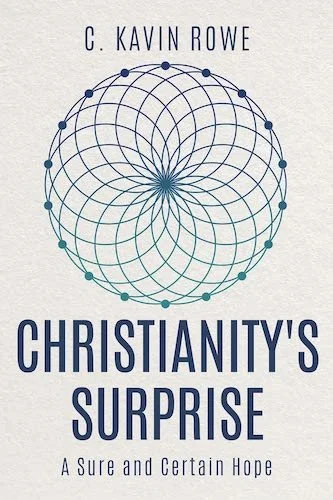Christianity’s Surprise
C. Kavin Rowe’s short book Christianity’s Surprise: A Sure and Certain Hope (Abingdon) packs a punch. In less than 100 pages, Rowe places a bull’s eye on the resurrection of Jesus as the singular earth-shaking reality that defines Christian faith. The resurrection not only explains the “surprising” rise of the early church but also animates any Christian witness today that is truly hope-filled.
In Rowe’s telling, “resurrection hope” is about so much more than inner tranquility as individuals face the frightening prospect of the end of life. It’s not less than that, but it’s so much more. Resurrection hope is good news for bodies—especially vulnerable, marginalized bodies—and for entire societies in turn.
“The earliest Christians knew that to make the truth of Jesus and his image known to the world they had to do more than just announce his arrival,” Rowe writes. “They needed to create ways of seeing and being that had not yet existed.” So what did they do? They got to work, creating “communities and institutions that took up space in public and made explicit through their order, structure, and practices what the human was in light of Christ.”
You may want to go back and read that paragraph again.
Early Christians were eager to share the good news of the risen Christ. This was really good news, after all! They knew that the resurrection changed everything, and they understood that new “ways of seeing and being” would be required. They didn’t make clever tracts disguised as $50 bills. They didn’t create mass hysteria about the enemies of the faith, real as those enemies surely were.
No, they built institutions and cultivated communities that became impossible to ignore. And who did those communities and institutions aim to serve? They were established to serve the sick and the poor. This, too, was totally new and “surprising” in the world of their day:
“The Roman world knew of poor people and sick people, of course, but it had never seen the ‘poor’ as a distinct group of vulnerable people that required response, and it did not know what it was to care for the sick during a plague in spite of the risk to oneself. The Christians, however, had learned through the story of everything that they were not to fear death, that they were to see Christ in the face of the poor and the sick, and that they were to be present to them and provide for them, come what may. The sharing of resources—first among many fellow Christians, and then beyond—nursing and doctoring during the plagues, the invention of the hospital and shelters for the poor. These were all Christian surprises for the world.”
It was only natural that these “surprising” efforts began with care for the poor and vulnerable children, women, and men in their own midst. But soon, “the radical commitment to see Christ’s face and blessing in the poor” led these Christians to seek out those in need wherever and whoever they were—regardless of belief or ethnicity or potentially questionable life decisions. As a matter of fidelity to the gospel, these Christians sought out hurting people that they might be relieved. Rowe cites the renowned historian and Augustine biographer Peter Brown, who writes that this profound “new departure” by the early Christians “threw open the horizons of society.”
These early Christians were living in a context in which they were not dominant, where they were in fact being martyred on the regular. Even so, day by day these resurrection people were fundamentally altering the landscape—not in pursuit of power or some illusion of cultural relevancy, but because they knew, in their bones, that a faithful witness to the risen Christ “required innovative structures that manifested the truth through their surprising existence in a world that had never seen them, did not anticipate them, and longed for them all the same.”
Resurrection hope is really good news. It’s what the world longs for. It’s what we need.
